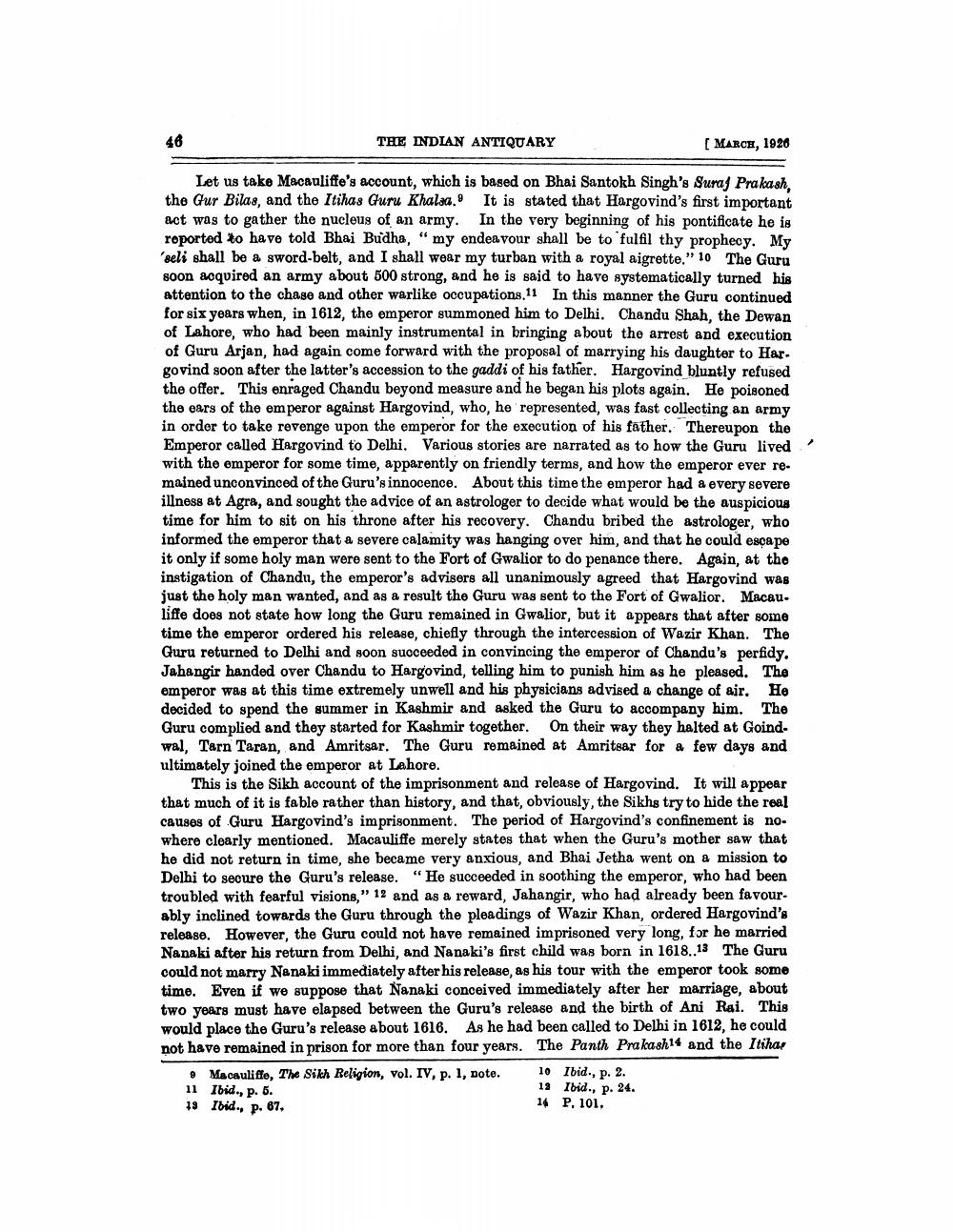________________
THE INDIAN ANTIQUARY
[ MARCH, 1926
Let us take Macauliffe's account, which is based on Bhai Santokh Singh's Suraj Prakash, the Gur Bilas, and the Itihas Guru Khalsa. It is stated that Hargovind's first important act was to gather the nucleus of an army. In the very beginning of his pontificate he is reported to have told Bhai Budha, "my endeavour shall be to fulfil thy prophecy. My 'seli shall be a sword-belt, and I shall wear my turban with a royal aigrette." 10 The Guru soon acquired an army about 500 strong, and he is said to have systematically turned his attention to the chase and other warlike occupations.11 In this manner the Guru continued for six years when, in 1612, the emperor summoned him to Delhi. Chandu Shah, the Dewan of Lahore, who had been mainly instrumental in bringing about the arrest and execution of Guru Arjan, had again come forward with the proposal of marrying his daughter to Hargovind soon after the latter's accession to the gaddi of his father. Hargovind bluntly refused the offer. This enraged Chandu beyond measure and he began his plots again. He poisoned the ears of the emperor against Hargovind, who, he represented, was fast collecting an army in order to take revenge upon the emperor for the execution of his father. Thereupon the Emperor called Hargovind to Delhi. Various stories are narrated as to how the Guru lived with the emperor for some time, apparently on friendly terms, and how the emperor ever remained unconvinced of the Guru's innocence. About this time the emperor had a every severe illness at Agra, and sought the advice of an astrologer to decide what would be the auspicious time for him to sit on his throne after his recovery. Chandu bribed the astrologer, who informed the emperor that a severe calamity was hanging over him, and that he could escape it only if some holy man were sent to the Fort of Gwalior to do penance there. Again, at the instigation of Chandu, the emperor's advisers all unanimously agreed that Hargovind was just the holy man wanted, and as a result the Guru was sent to the Fort of Gwalior. Macau. liffe does not state how long the Guru remained in Gwalior, but it appears that after some time the emperor ordered his release, chiefly through the intercession of Wazir Khan. The Guru returned to Delhi and soon succeeded in convincing the emperor of Chandu's perfidy. Jahangir handed over Chandu to Hargovind, telling him to punish him as he pleased. The emperor was at this time extremely unwell and his physicians advised a change of air. He decided to spend the summer in Kashmir and asked the Guru to accompany him. The Guru complied and they started for Kashmir together. On their way they halted at Goindwal, Tarn Taran, and Amritsar. The Guru remained at Amritsar for a few days and ultimately joined the emperor at Lahore.
46
This is the Sikh account of the imprisonment and release of Hargovind. It will appear that much of it is fable rather than history, and that, obviously, the Sikhs try to hide the real causes of Guru Hargovind's imprisonment. The period of Hargovind's confinement is nowhere clearly mentioned. Macauliffe merely states that when the Guru's mother saw that he did not return in time, she became very anxious, and Bhai Jetha went on a mission to Delhi to secure the Guru's release. "He succeeded in soothing the emperor, who had been troubled with fearful visions," 12 and as a reward, Jahangir, who had already been favourably inclined towards the Guru through the pleadings of Wazir Khan, ordered Hargovind's release. However, the Guru could not have remained imprisoned very long, for he married Nanaki after his return from Delhi, and Nanaki's first child was born in 1618..13 The Guru could not marry Nanaki immediately after his release, as his tour with the emperor took some time. Even if we suppose that Nanaki conceived immediately after her marriage, about two years must have elapsed between the Guru's release and the birth of Ani Rai. This would place the Guru's release about 1616. As he had been called to Delhi in 1612, he could not have remained in prison for more than four years. The Panth Prakash14 and the Itihas
9 Macauliffe, The Sikh Religion, vol. IV, p. 1, note.
11 Ibid., p. 5. 13 Ibid., p. 67.
10
12
14
Ibid., p. 2.
Ibid., p. 24.
P. 101.




